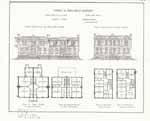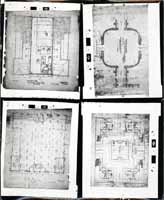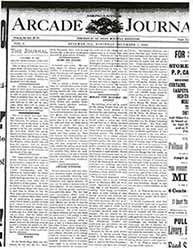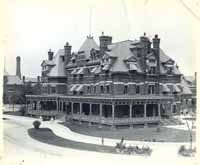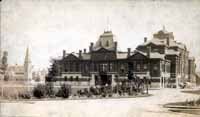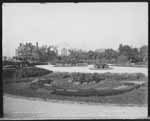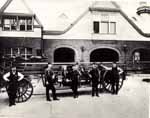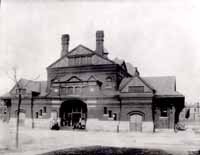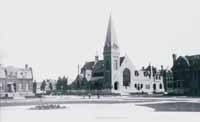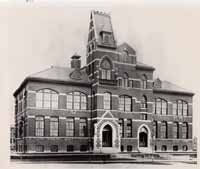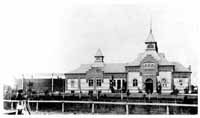Planning the Town
You are at Home -> The Town of Pullman -> Planning the Town of PullmanPlanning the Town of Pullman
Pullman hired Solon Beman to design the town and factory of Pullman and Nathan Barrett to design the integrated landscape design. Unlike today, where most people arrive to Pullman by car, in the 1880's people arrived by train. Pullman's "front yard", therefore, faced the railroad tracks, and was centered around the Pullman train station, which was located on 111th just west of the Metra Electric Tracks. Looking southwest. Cottage Grove Avenue now runs through the middle of what used to be Lake Vista, which served a dual function - it collected the condensation from the great Corliss Engine that powered the machinery in Pullman, and it also served as a reflecting pool for the Clock Tower. The lakeshore and the adjoining Clock Tower landscape were planted primarily with lawn, and dotted artistically with low trees and shrubs in order to accentuate, not to obscure the view of the Clock Tower. Looking down 111th Street. The street, paved with macadam, was lined with maple trees, creating a formal alley all the way down to Lake Calumet, whose shoreline extended to where the police station is located today. In Lake Calumet was Athletic Island, which had on it ball fields, a running track, and grandstands, from which people could watch the regattas run on the lake. Looking Southeast. Originally, there would have been a large circle-shaped, formal flowerbed in the middle of what today is 111th Street and Cottage Grove. There were several such intersection circle beds in Pullman to soften the strict formality of the grid system of the rest of the town. Barrett was fond of such pleasing "juxtapositions" - pitting the formal against the informal. Cottage Grove, originally, was a narrow, winding carriage path that snaked its way from 107th Street (where there was another intersection circle bed) between Lake Vista and the Clock Tower, and to the front door of the Arcade Building. This "serpentine" pathway, as Barrett called it, provided yet more juxtaposition against the formal grid system. Barrett designed Pullman to resemble a suburban park -- a radical notion for a working class community. Each row house had a small front yard. A variety of trees were planted along the parkways. While the Pullman Company still owned all the housing stock, company employees performed landscape maintenance. The company greenhouse and nursery, located near the shore of Lake Calumet at the end of 112th Street, cultivated more than 70 species of shrubs and trees, and 125 varieties of plants. More than 100,000 flowering plants were raised each year, circa 1892. After 1894 (the year of the nation-wide strike that began in Pullman) and certainly after 1897 (the year of George Pullman's death) the original landscape began to be dismantled -- Lake Vista was filled in; Arcade Park was razed; winding carriage paths were abolished in favor of what today is known as Cottage Grove Avenue; and company landscape maintenance waned, then ceased altogether. Although it is not unusual for the majority of time and attention to focus on historic buildings, the Pullman layout and landscape was as vital to the overall appearance of the nation's first planned industrial town as were its storied buildings. Perhaps one day, Barrett's original landscape designs will be restored. Beman's design for Pullman consisted largely of elements typical of American Queen Anne. Although most Queen Anne buildings are of wood, Beman used brick, a medium more classically oriented than wood. American Queen Anne is a style combining the irregularities of plan and massing associated with Gothic Revival. Many Queen Ann structures make use of several different types of materials in order to reinforce the picturesque massing with contrasts in color and texture. Beman made a special effort to introduce variety and imagination in the facades of the row houses to avoid the monotony one sees in cookie cutter communities today. Brickwork is often constructed in intricate patters (scintling), the same elaborate modeling of cut or molded brick is often featured in the chimneys. The upper floors often feature fish scale shingles and or narrow clapboarding. While few Queen Anne houses are symmetrically designed, most reflect instead a concept of balance. Elements in the elevations are weighted against each other to achieve a sense of repose without symmetry. The Administration Building and Clock Tower formed the central mass of a monumental structure seven hundred feet long. Its architectural design reflects mixed heritage. As both real and symbolic expression of the great economic power, which was the Pullman Company, it was essential the building display a strong sense of formal ordering. At the center rises the clock tower and roof, which was echoed in the shapes of the gabled pavilions which marked the outer end of the long facade. The entire structure is oriented with the most impressive elevation to the west away from the town, which served it, and toward the Illinois Central. The power and majesty of the building was intensified by its mirror image in Lake Vista, the artificial lake that once stood before it. The central pavilion with its clock tower clearly expresses where the center of authority stood. It is hard to imagine what vista was afforded to visitors arriving by train, as most did, when they looked in awe at the grandeur of the factory, the gardens, the hotel and the arcade. The architectural heritage reflected in the Administration Building descends from the formal symmetrical ordering of elements associated with French architecture of the 17th and 18th centuries. The formality is emphasized by the landscape treatment of the area surrounding the building. The costuming style of the building ornamentation descends from romantic naturalistic heritage largely borrowed form England. In an attempt to harmonize the Administration Building with the rest of the town, Beman has been forced to introduce a wide variety of both arched and rectilinear forms into his fa?de in an attempt to disguise the fact that is so rigidly symmetrical. The arched shapes in both the tower and end pavilion contrasts with the angular statements made by the regularly spaced skylights of the factory wings. The buildings were ventilated with numerous windows and skylights and the interiors were painted light colors to maximize natural light making working condition in the factory complex better than most for the time. This delicate, airy, salubrious construction resulted, ironically, in the early demise of the building's structure. The skylights were framed entirely of wood ? the quality of fine cabinetry, but entirely inappropriate to withstand the elements over the years.Nathan Franklin Barrett
Nathan Franklin Barrett was born on Staten Island, New York, the son of a prominent businessman. After turns as a sailor, then a soldier in the Civil War, Barrett began work at a nursery his father had established. Largely self-taught, his earliest landscape design work included station grounds for the New Jersey Central Railroad. In the 1870's, George Pullman retained Barrett to "study his oceanfront property at Elberon." Soon thereafter, in collaboration with Solon Spencer Beman, Barrett began to design the model town of Pullman. Beman designed the buildings, and Barrett was responsible for siting them and designing the landscapes. Barrett remained close friends with Pullman until Pullman's death in 1897. Barrett's design of the Pullman community led to his involvement in other towns and suburban residential developments, including Chevy Chase, MD; Fort Worth, TX, and Birmingham, AL. In addition to his planning achievements, Barrett designed landscapes for many country places of prominent industrialists and businessmen. Many of Barrett's design elements for Naumkeag, the home of Joseph H. Choate in Stockbridge, MA, remain intact to this day. In 1895, Barrett was appointed landscape architect of the Essex County (New Jersey) Park Commission, where he designed parks and the layout of boulevards connecting them. He served as a commissioner of the Palisades Inter-State Parkway (located in New Jersey and New York) from 1900 to 1915. Most notably, in 1903, he was elected president of the American Society of Landscape Architects, having been one of the driving forces in its initial formation. Barrett is buried in Oakwoods Cemetery SW of Hyde Park.Solon Spencer Beman
Beman was the son of an architecture "buff" with a large library on the subject. At the age of 14 he apprenticed with Richard Upjohn, and remained with him for eleven years. At the age of twenty-six he designed a home for George Pullman in New Jersey and was commissioned to redesign Pullman?s Prairie Avenue home. Impressed with his work, Pullman asked Beman to design the town of Pullman.Famed architect Louis Sullivan wrote: "I doubt if any architect in the country could have produced work superior to that of Mr. Beman, it was a huge undertaking for so young a man." Beman did not proclaim any architectural theory like Sullivan, and this, coupled with that so many of his buildings have been demolished, accounts for his relative obscurity. His architectural career is closely linked to the transportation industry. Other notable buildings by Beman in Chicago are the Fine Arts Building on Michigan Avenue, and the Dearborn Station at the foot of Dearborn in the loop that has been recycled into more contemporary use. He designed the Rosalie Villas on 57th and 58th Streets at Harper Avenue in Hyde Park, and the Kimball House at 18th and Prairie across the street from where the Pullman Mansion stood..
Beman rarely discussed his work, and when he did, he did it laconically. At the opening of one of his buildings in Terre Haute, Indiana, he quoted an architect in Charles Dickens's Martin Chuzzlewit: "My friends... my duty is to build, not speak; to act, not to talk; to deal with marble, stone and brick, not language."
THE PULLMAN HISTORY SITE

More Information About the Town of Pullman
Planning the town
The Arcade Journal
The Hotel Florence
The Arcade
Arcade Park
The Stables
Market Hall
Area Churches
Area Schools
The Freight Depot and the Railway Station
Other Pullman Buildings
The Pullman House History Project
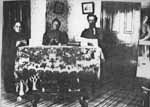
Arranged by:
Name
Address
Occupation
Birthplace
People of Color
Maps of Pullman
Images of the Town of Pullman
All images of the town
Vistas
Art & Architecture
- Landscape architect Nathan Franklin Barrett
- Architect Solon Spencer Beman
- Henry Koopman and Family, Photographer
- Landscape Design
Pullman’s Neighborhood
- The Calumet River
- IHACCR
- Area Churches
- The Kensington Neighborhood
- Lake Calumet
- North Pullman
- The Roseland Neighborhood
Buildings in Pullman
- The Arcade Building
- Arcade Park
- Carriage House
- Casino Building
- Fire Department
- Freight Depot
- Gas Works
- The Hotel Florence
- Hospital
- Houses
- Market Hall
- Schools
- Stable
- Train Station
Other Pullman-Related Sites
- Historic Pullman Garden Club - An all-volunteer group that are the current stewards of many of the public green spaces in Pullman. (http://www.hpgc.org/
- Historic Pullman Foundation - The HPF is a non-profit organization whose mission is to "facilitate the preservation and restoration of original structures within the Town of Pullman and to promote public awareness of the significance of Pullman as one of the nation's first planned industrial communities, now a designated City of Chicago, State of Illinois and National landmark district." (http://www.pullmanil.org/)
- The National A. Philip Randolph Pullman Porter Museum is a 501(c)3 cultural institution. Its purpose is to honor, preserving present and interpreting the legacy of A. Philip Randolph, Pullman Porters, the Brotherhood of Sleeping Car Porters and the contributions made by African-Americans to America's labor movement. ((http://www.nationalpullmanportermuseum.com/)
- Pullman Civic Organization - The PCO is a strong and vibrant Community Organization that has been in existence since 1960. (http://www.pullmancivic.org/)
- Pullman National Monument - The official page of the Pullman National Park. (https://www.nps.gov/pull/)
- South Suburban Genealogical & Historical Society - SSG&HS holds the Pullman Collection, consisting of personnel records from Pullman Car Works circa 1900-1949. There are approximately 200,000 individuals represented in the collection. (https://ssghs.org/)
- The Industrial Heritage Archives of Chicago's Calumet Region is an online museum of images that commemorates and celebrates the historic industries and workers of the region, made possible by a Library Services and Technology Act grant administered by the Illinois State Library. (http://www.pullman-museum.org/ihaccr/)
- Illinois Digital Archives (IDA) is a repository for the digital collections libraries and cultural institutions in the State of Illinois and the hosting service for the online images on this site. (http://www.idaillinois.org/)
